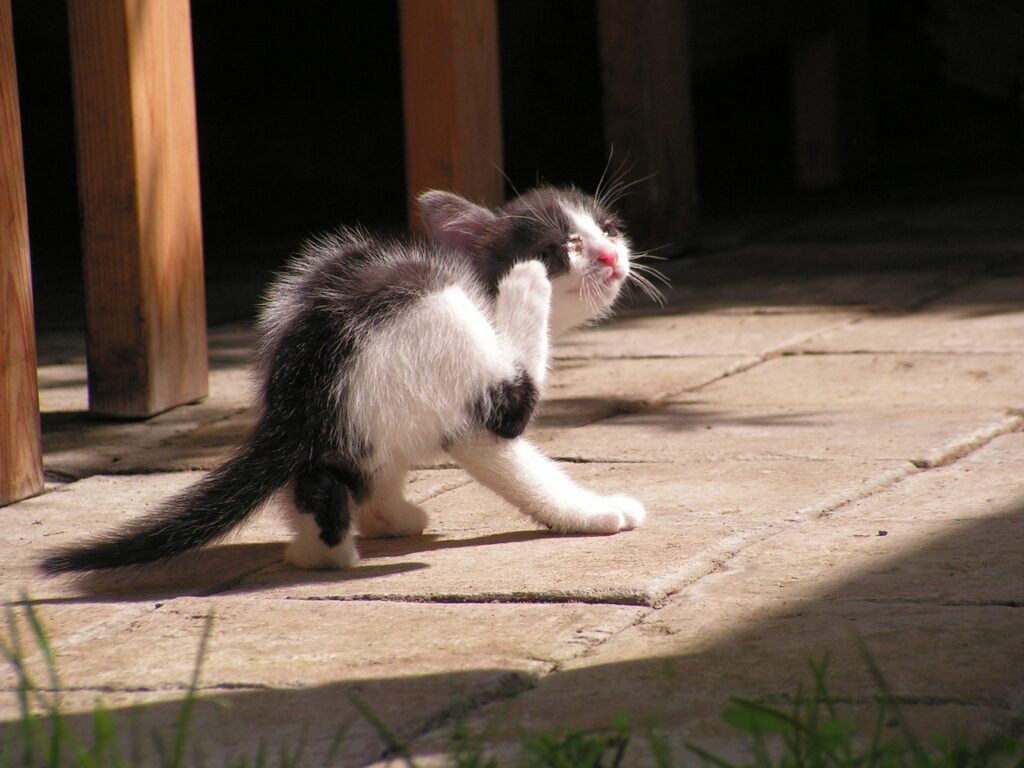Wondering how to give a cat a pill? It’s no secret that giving a cat a tablet isn’t the easiest job in the world. Cats are clever creatures, which can make the job trickier -they wriggle, and I’ve known a fair few spit the tablet out in secret, when they think you aren’t looking!
As a veterinary nurse, I’ve given a lot of cats pills. Trust me when I say it has taken time to master the technique! Even so – to this day – my own cat is troublesome to tablet. I hope my tips will help you learn how to give a cat a pill (and other medications!).
How to give a cat a pill
The golden question – how do I give my cat a pill? You’ll be pleased to know there are a few tips and tricks I can share to make this easier for both you and your feline friend.
Hiding medicine in treats
When your vet or vet nurse dispenses medication to you, it is always worth double-checking whether the medication can/should be given with food, or if it can/should be split or crushed. Food can really work in your favour and may save you having to put the pill in your cat’s mouth. Some medications are flavoured, too, and if your cat is food motivated, they may voluntarily eat it. My parent’s cat happily does this with his beef-flavoured flea preventative tablet!
Some top tips for giving pills in food include:
- Make sure your cat is hungry, so they are more likely to eat
- Don’t let your cat see you hide it
- Hide the medication as well as you can
- Use a strong-smelling, tasty food that they like (e.g. jelly from wet food, soft cheese, small amount of butter, small amount of meat or cheese). Cats have a super-strong sense of smell, so the aim of this is to mask the tablet
- Special ‘pill pocket’ treats are available – these have a hole inside for hiding medications in and are very strongly scented
- If they aren’t taking it in their usual bowl, try offering it (inside a treat) on your fingertips.
When hiding pills in food it is always worth checking they have eaten it afterwards. You should also check where they go after eating in case they spit it out.
Putting a tablet into your cat’s mouth
Sometimes your cat’s medicine needs giving without food or your cat won’t take pills in food. In this case, you may need to give your cat a pill into their mouth. For this, I recommend the following technique:
- Have your cat on a non-slippery surface (a towel sprayed with Feliway is ideal) with them facing away from you.
- Ideally, have a second person present to gently hold your cat. Wrapping the cat in the towel can work, or they may be able to gently restrain the front legs above the elbows. If a second person isn’t available, tuck the cat’s body under your non-dominant arm and support the body gently using your elbow. Alternatively, kneel on the floor, with the cat between your knees – your body will prevent the cat from reversing while you give them their pill.
- Hold the tablet between your thumb and forefinger.
- With the free (usually non-dominant) hand, place the thumb and index or middle finger either side of the cat’s head and gently but firmly tilt the head upwards.
- Use the middle finger of the hand holding the tablet to gently pull the lower jaw down to open the mouth.
- Drop the tablet to fall on the back of the tongue
- Close the mouth, let the head drop slightly (but not all the way, you still want gravity to be helping that pill to the back of the throat) and gently stroke their throat. You can try tapping their nose or blowing gently on their nose to encourage them to swallow.
- They have swallowed if they lick their lips/nose
- Syringe some water into the side of their mouth or offer some food afterwards. This helps the tablet travel to the stomach rather than lodging in the gullet (oesophagus).
Using pill poppers and other medication aids
There are also equipment aids to help giving the medication if your cat won’t take it in food. ‘Pill poppers’ live up to their name – following the same technique as above, instead of dropping the tablet onto the back of the tongue, you can ‘pop’ the pill there using this device. It is simple to use, and they are available to buy from most veterinary practices or online. Do make sure you use a soft-top pill popper, though, as these are less harsh and painful on your cat’s mouth and teeth if they start chomping down on it.
Gelatine capsules are also an option. The medication goes inside the capsule – which can hold multiple at one time (bonus!) – and it masks the taste, as well as saving you having to give multiple at once, if your cat is on a few tablets per day. These can be given in food, too, or via the above method.
The video below from the International Society of Feline Medicine (ISFM) shows how to give a cat a pill.
How to give a cat liquid medication
As with tablets, ask your vet or vet nurse whether the medication can be given with food. If the medicine can be given with food, our top tips for giving a cat a pill above will help!
If your cat won’t eat their food with the medication in, then the method for giving it is similar to giving a cat tablets:
- Make sure the medication is already drawn up in the syringe provided and the dose is correct.
- Hold your cat in such a way that they feel secure – a non-slippery surface works well – and can’t back away. If a second person isn’t available to help, tuck the cat’s body under your non-dominant arm and support the body gently using your elbow. Alternatively, kneel and use your body to prevent the cat reversing while you give their medication.
- With your free hand, place the thumb and index or middle finger either side of the cat’s head and gently but firmly tilt the head upwards. You don’t need to tip the head as far back with liquid medication.
- Gently insert the syringe into the corner of your cat’s mouth and push the plunger to administer the medication. If there is a lot of liquid to give, be sure to take a break so your cat has chance to swallow.
- Offer a nice treat afterwards!
What if my cat won’t take their medicine?
This is very common with cats. It’s frustrating, but please don’t give up or feel disheartened. Your vet and/or vet nurse will be more than happy and willing to help you. Give them a call, and see if they can give you a demonstration on how to give the medication, or if your cat needs the medicine infrequently (for example, some preventative medicines like flea treatments) and your cat travels well, you could ask them to do it for you.
Your vet may be able to recommend and prescribe a different medication, too. This isn’t always possible, but some have alternatives which you may find easier due to different taste, sizing or formulation. ISFM have an ‘Easy To Give’ award scheme for medications which are easy to give to cats, so this could be a discussion point for you and your vet. We list alternatives to each medication in our pet medicines database, which may help you see what options could be available. Remember, the decision whether an alternative medication is suitable for your pet is down to your individual vet, so you’ll need to talk to them about your concerns.
Conclusion
You aren’t alone wondering how to give a cat a pill. In fact, it’s very common for people to struggle with their pet’s medications. Medications that can be given in food or hidden in treats tend to be easier. There are also more liquid and flavoured alternatives being developed for cats. That said, sometimes you just need to give a cat their tablet – in which case, our tips above should help. Remember, if you’re struggling, talk to your vet – they can’t suggest an alternative or help you with tips unless you let them know!
- How to make 4 DIY cat food puzzle toys - September 2, 2024
- How to give a cat a pill (and every other medication too!) - July 30, 2024



